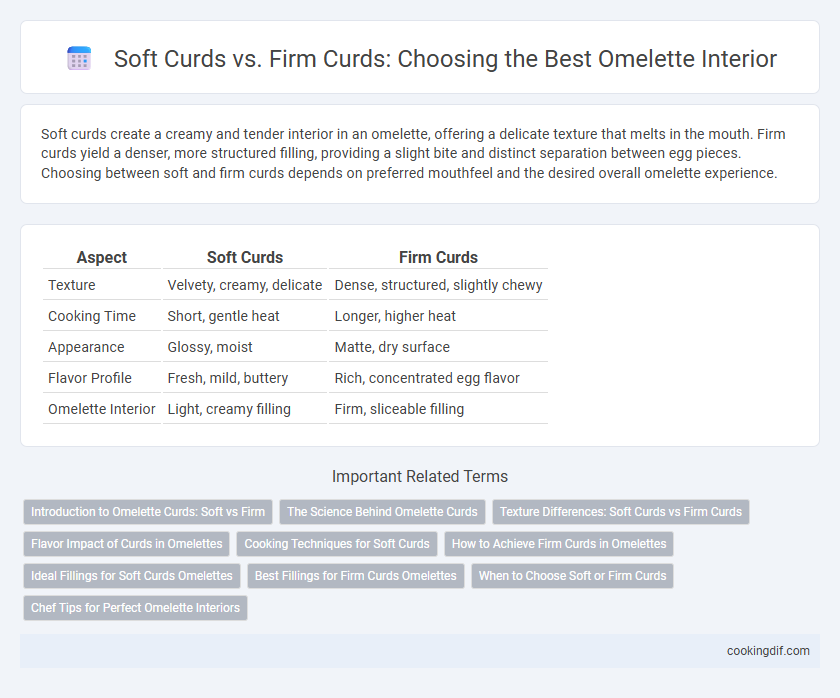Soft curds create a creamy and tender interior in an omelette, offering a delicate texture that melts in the mouth. Firm curds yield a denser, more structured filling, providing a slight bite and distinct separation between egg pieces. Choosing between soft and firm curds depends on preferred mouthfeel and the desired overall omelette experience.
Table of Comparison
| Aspect | Soft Curds | Firm Curds |
|---|---|---|
| Texture | Velvety, creamy, delicate | Dense, structured, slightly chewy |
| Cooking Time | Short, gentle heat | Longer, higher heat |
| Appearance | Glossy, moist | Matte, dry surface |
| Flavor Profile | Fresh, mild, buttery | Rich, concentrated egg flavor |
| Omelette Interior | Light, creamy filling | Firm, sliceable filling |
Introduction to Omelette Curds: Soft vs Firm
Omelette curds form the interior texture that defines the dish's creaminess and structure, with soft curds creating a tender, custard-like consistency ideal for delicate and creamy omelettes. Firm curds result from longer cooking, yielding a denser, more rubbery interior favored in traditional French-style or folded omelettes that hold fillings securely. Understanding the balance between soft and firm curds helps chefs control moisture, texture, and flavor intensity to achieve the perfect omelette tailored to personal or regional preferences.
The Science Behind Omelette Curds
Omelette curds form through the coagulation of egg proteins, primarily ovalbumin, triggered by heat. Soft curds result from gently cooked eggs where proteins denature slowly, preserving moisture and creating a tender, creamy texture. Firm curds form under higher heat or prolonged cooking time, causing tighter protein networks that expel more water and yield a denser, drier interior.
Texture Differences: Soft Curds vs Firm Curds
Soft curds create a creamy, tender interior in omelettes, resulting from lower heat and gentle stirring that prevent moisture loss. Firm curds develop through higher heat and more vigorous cooking, yielding a denser, slightly rubbery texture with less moisture retention. The choice between soft and firm curds significantly impacts the mouthfeel and overall eating experience of the omelette.
Flavor Impact of Curds in Omelettes
Soft curds in an omelette create a creamy, tender texture that enhances flavor absorption, delivering a rich and buttery taste throughout each bite. Firm curds offer a denser, more structured interior that intensifies the natural egg flavor while providing a slightly chewy contrast. Choosing between soft and firm curds directly influences the omelette's mouthfeel and flavor profile, shaping a delicate balance between creaminess and robustness.
Cooking Techniques for Soft Curds
Soft curds in an omelette result from gently cooking beaten eggs over low heat while continuously stirring and folding to create a creamy, custard-like texture. This technique preserves moisture and produces tender curds that melt in the mouth, contrasting with firm curds that form under higher heat and less agitation. Mastering the gentle folding method enhances the omelette's interior, yielding a delicate, silky finish prized in classic French cooking.
How to Achieve Firm Curds in Omelettes
Achieving firm curds in omelettes requires cooking eggs at a higher temperature while continuously stirring to promote coagulation without overcooking. Using whole eggs or adding dairy such as cream stabilizes protein structure, creating a dense, well-defined texture. Finishing with residual heat off the stove ensures even firmness and prevents the interior from becoming rubbery.
Ideal Fillings for Soft Curds Omelettes
Soft curds in omelettes create a creamy, tender interior perfect for delicate fillings such as fresh herbs, creme fraiche, or smoked salmon, which complement the smooth texture without overpowering it. The gentle curd consistency allows soft cheeses like goat cheese or ricotta to meld seamlessly, enhancing the overall flavor and richness. Light vegetables such as sauteed mushrooms, spinach, or thinly sliced avocado maintain the omelette's softness, ensuring a balanced bite with every mouthful.
Best Fillings for Firm Curds Omelettes
Firm curds in omelettes create a denser texture that holds up well to hearty, robust fillings. Ingredients like sauteed mushrooms, sharp cheddar, smoked ham, and caramelized onions complement the firm structure by providing contrasting flavors and textures. This combination ensures each bite maintains its shape while delivering a rich, satisfying taste profile perfect for a substantial meal.
When to Choose Soft or Firm Curds
Soft curds create a creamy, tender interior ideal for a delicate, custard-like omelette best suited for gentle cooking methods and immediate serving. Firm curds provide a more structured, drier texture preferred in heartier omelettes that hold fillings well and are suitable for slower cooking or baking techniques. Choosing between soft and firm curds depends on the desired texture, cooking time, and the balance of moisture versus structural integrity in the finished omelette.
Chef Tips for Perfect Omelette Interiors
For achieving the perfect omelette interior, chefs recommend gently stirring eggs over low heat to create soft curds, resulting in a creamy and tender texture. Firm curds form when eggs are cooked at higher temperatures or stirred less, producing a denser and more set interior preferred for filling stability. Mastering heat control and stirring techniques ensures optimal curd formation, balancing softness and firmness for a flawless omelette.
Soft Curds vs Firm Curds for omelette interior Infographic

 cookingdif.com
cookingdif.com